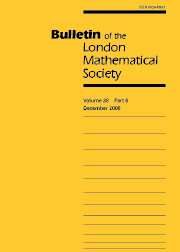Crossref Citations
This article has been cited by the following publications. This list is generated based on data provided by
Crossref.
Qiu, S.-L.
and
Vuorinen, M.
2004.
Some properties of the gamma and psi functions, with applications.
Mathematics of Computation,
Vol. 74,
Issue. 250,
p.
723.
2006.
The Mathematica GuideBook for Symbolics.
p.
1.
Gómez, Francisco J.
and
Sesma, Javier
2007.
Connection factors in the Schrödinger equation with a polynomial potential.
Journal of Computational and Applied Mathematics,
Vol. 207,
Issue. 2,
p.
291.
Batir, Necdet
2007.
On some properties of digamma and polygamma functions.
Journal of Mathematical Analysis and Applications,
Vol. 328,
Issue. 1,
p.
452.
Malešević, Branko J.
2007.
One Method for Proving Inequalities by Computer.
Journal of Inequalities and Applications,
Vol. 2007,
Issue. ,
p.
1.
Batir, Necdet
2008.
On some properties of the gamma function.
Expositiones Mathematicae,
Vol. 26,
Issue. 2,
p.
187.
Zhang, Xiaoming
and
Chu, Yuming
2009.
A Double Inequality for Gamma Function.
Journal of Inequalities and Applications,
Vol. 2009,
Issue. 1,
p.
503782.
Mortici, Cristinel
2010.
Ramanujan formula for the generalized Stirling approximation.
Applied Mathematics and Computation,
Vol. 217,
Issue. 6,
p.
2579.
Nemes, Gergő
2010.
Asymptotic expansion for log n! in terms of the reciprocal of a triangular number.
Acta Mathematica Hungarica,
Vol. 129,
Issue. 3,
p.
254.
Şevli̇, Hamdullah
and
Batır, Necdet
2011.
Complete monotonicity results for some functions involving the gamma and polygamma functions.
Mathematical and Computer Modelling,
Vol. 53,
Issue. 9-10,
p.
1771.
Mortici, Cristinel
2011.
Improved asymptotic formulas for the gamma function.
Computers & Mathematics with Applications,
Vol. 61,
Issue. 11,
p.
3364.
Chen, Chao-Ping
and
Lin, Long
2012.
Remarks on asymptotic expansions for the gamma function.
Applied Mathematics Letters,
Vol. 25,
Issue. 12,
p.
2322.
Bhayo, Barkat Ali
and
Vuorinen, Matti
2012.
On generalized trigonometric functions with two parameters.
Journal of Approximation Theory,
Vol. 164,
Issue. 10,
p.
1415.
Andrews, George E.
and
Berndt, Bruce C.
2013.
Ramanujan's Lost Notebook.
p.
111.
Chen, Chao-Ping
2013.
Unified treatment of several asymptotic formulas for the gamma function.
Numerical Algorithms,
Vol. 64,
Issue. 2,
p.
311.
Andrews, George E.
and
Berndt, Bruce C.
2013.
Ramanujan's Lost Notebook.
p.
1.
Hirschhorn, Michael D.
and
Villarino, Mark B.
2014.
A refinement of Ramanujan’s factorial approximation.
The Ramanujan Journal,
Vol. 34,
Issue. 1,
p.
73.
Chen, Chao-Ping
and
Liu, Jing-Yun
2015.
Inequalities and asymptotic expansions for the gamma function.
Journal of Number Theory,
Vol. 149,
Issue. ,
p.
313.
Chen, Chao-Ping
2015.
Inequalities and asymptotic expansions associated with the Ramanujan and Nemes formulas for the gamma function.
Applied Mathematics and Computation,
Vol. 261,
Issue. ,
p.
337.
Chen, Chao-Ping
and
Lin, Long
2016.
Inequalities and asymptotic expansions for the gamma function related to Mortici's formula.
Journal of Number Theory,
Vol. 162,
Issue. ,
p.
578.

